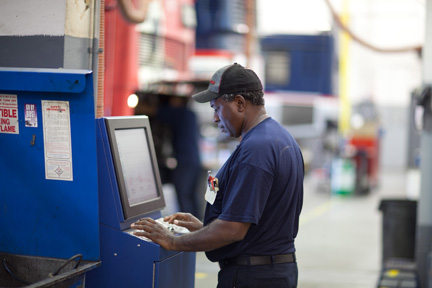
By Mark Aesch

The current belt-tightened economic climate has created the need for public and private sector enterprises alike to explore new areas within their operations for cost-savings and improved efficiencies. At Rochester Genesee Regional Transportation Authority (RGRTA), Rochester, NY, we are known for managing our mid-sized transit organization like a private business. This mindset drives us to actively explore and test new and innovative ideas that produce cost savings and improved efficiencies that will ultimately help us to reduce our reliance on taxpayer subsidies. Only when these ideas, theories, and hypotheses can be monitored and measured for performance do we fully embrace and incorporate them into our operating processes.
In our first year of examination in hopes of saving time and money, we are well into one new avenue of operational change, which involves our deployment of a reliable vendor managed inventory program (VMI). VMI removes us from the business of managing and warehousing parts. Floor-to-ceiling shelves of product and parts tie up money we could use elsewhere in the business.
We have partnered with Neopart, a longtime supplier to the transit industry, to build an on-demand inventory system with the ultimate goal of 100-percent first time fulfillment. Neopart’s experience and knowledge of the transit industry combined with its skill in supply chain management enables the company to efficiently link us to its network of suppliers. In addition, Neopart’s buying power opens the door to substantial cost savings on the parts we purchase.
Certainly anyone who has stocked parts is familiar with costs incurred with buying and holding inventory. For a public transit authority, procuring parts can be a long and cumbersome due to our regulation-based bidding process. And let’s not overlook additional costs associated with personnel time required for handling the ensuing paperwork.
In this arcane scenario, who can blame a warehouse manager or procurement executive for opting to over buy and line shelves with stock for just in case as opposed to just in time.
Most inventory managers will readily admit parts obsolescence is the major risk associated with holding excessively high inventories. An expired part is money out the window.

At its core, the VMI system works because the supplier has access to demand information from the transit system and has the responsibility to maintain the inventory so that high availability rates are achieved. The parts manager has the ability to bring information systems, sourcing knowledge and full supply chain visibility so it can deliver the part that is needed quickly and at the best price.
Additionally, the VMI system fundamentally alters the supply chain ordering process by consolidating administration and procurement work in the supplier’s processes, which generates substantial operational cost savings. The result is lower operating costs, less inventory investment, and higher inventory availability.
Now into our fourth quarter of our VMI system, I can safely say that we will be making refinements to the VMI system, but by all accounts it appears to be promising.
This is innovative work that builds close relationships, as well as movement away from staid practices that has allowed us at RGRTA to provide higher quality service and actually reduce our bus fares. We are putting our money where it benefits our customer, rather than wasting it in dusty old stock rooms. Let’s face it, inventory is waste. We have much better things to do with our money and our limited facility space.
Mark Aesch serves as president and CEO of Rochester Genesee Regional Transportation Authority (RGRTA), Rochester, NY, and is the author of the just-released, Driving Excellence, which details the reconstruction of the Authority’s long-term strategic plan and operating philosophy.
